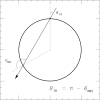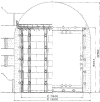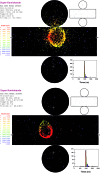Atmospheric neutrinos and discovery of neutrino oscillations
- PMID: 20431258
- PMCID: PMC3417797
- DOI: 10.2183/pjab.86.303
Atmospheric neutrinos and discovery of neutrino oscillations
Abstract
Neutrino oscillation was discovered through studies of neutrinos produced by cosmic-ray interactions in the atmosphere. These neutrinos are called atmospheric neutrinos. They are produced as decay products in hadronic showers resulting from collisions of cosmic rays with nuclei in the atmosphere. Electron-neutrinos and muon-neutrinos are produced mainly by the decay chain of charged pions to muons to electrons. Atmospheric neutrino experiments observed zenith-angle and energy dependent deficit of muon-neutrino events. Neutrino oscillations between muon-neutrinos and tau-neutrinos explain these data well. Neutrino oscillations imply that neutrinos have small but non-zero masses. The small neutrino masses have profound implications to our understanding of elementary particle physics and the Universe. This article discusses the experimental discovery of neutrino oscillations.
Figures




















Similar articles
-
Tau neutrinos favored over sterile neutrinos in atmospheric muon neutrino oscillations.Phys Rev Lett. 2000 Nov 6;85(19):3999-4003. doi: 10.1103/PhysRevLett.85.3999. Phys Rev Lett. 2000. PMID: 11056609
-
Observation of an ultra-high-energy cosmic neutrino with KM3NeT.Nature. 2025 Feb;638(8050):376-382. doi: 10.1038/s41586-024-08543-1. Epub 2025 Feb 12. Nature. 2025. PMID: 39939793 Free PMC article.
-
Measurement of Atmospheric Neutrino Oscillations at 6-56 GeV with IceCube DeepCore.Phys Rev Lett. 2018 Feb 16;120(7):071801. doi: 10.1103/PhysRevLett.120.071801. Phys Rev Lett. 2018. PMID: 29542976
-
Neutrino oscillations.Philos Trans A Math Phys Eng Sci. 2002 May 15;360(1794):921-38. doi: 10.1098/rsta.2001.0974. Philos Trans A Math Phys Eng Sci. 2002. PMID: 12804286 Review.
-
The Sun, neutrinos and Super-Kamiokande.Proc Jpn Acad Ser B Phys Biol Sci. 2020;96(6):204-233. doi: 10.2183/pjab.96.017. Proc Jpn Acad Ser B Phys Biol Sci. 2020. PMID: 32522939 Free PMC article. Review.
Cited by
-
Experimental verification of the standard model of particle physics.Proc Jpn Acad Ser B Phys Biol Sci. 2021;97(5):211-235. doi: 10.2183/pjab.97.013. Proc Jpn Acad Ser B Phys Biol Sci. 2021. PMID: 33980753 Free PMC article. Review.
References
-
- Pauli W. (1930) A letter to L. Meitner and her colleagues (Open letter to the participants of the conference at Tubingen).
-
- Minkowski P. (1977) μ → eγ at a rate of one out of 10 9 muon decays? Phys. Lett. B 67, 421–428
-
- Yanagida T. (1979) Horizontal gauge symmetry and masses of neutrinos. InProceedings of the Workshop on the Unified Theory and Baryon Number in the Universe (eds. Sawada O., Sugamoto A.). KEK Report No. 79–18, pp. 95–98
-
- Gell-mann M., Ramond P, Slansky R. (1979) Complex spinors and unified theories. InSuper-gravity (ed. van Nieuwenhuizen P., Freedman D.Z.). North-Holland, Amsterdam, pp. 315–321
-
- Maki Z., Nakagawa M., Sakata S. (1962) Remarks on the unified model of elementary particles. Prog. Theor. Phys. 28, 870–880

